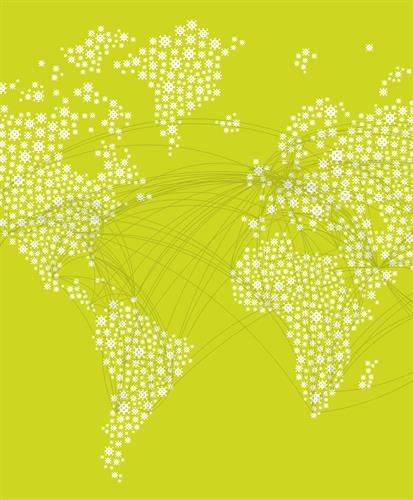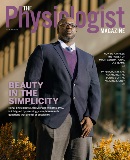The Physiologist Magazine
Read the Latest Issue
Don’t miss out on the latest topics in science and research.
View the Issue Archive
Catch up on all the issues of The Physiologist Magazine.
Contact Us
For questions, comments or to share your story ideas, email us or call 301.634.7314.
The Physiology of a Pandemic
As SARS-CoV-2 races across the globe, researchers explore what makes this virus more contagious—and deadlier—than most.
By Sarah Watts
 For Clement Chow, PhD, the virus came on suddenly in mid-March. It started with a fever. Chills
and aches quickly followed. A genetics researcher at the University of Utah, Chow had been following the news of a novel coronavirus called SARS-CoV-2 and knew that it was making its way rapidly across the globe. However, since there were only a few
dozen confirmed cases in Utah at the time, Chow was hopeful he had only come down with the flu. Then the coughing began.
For Clement Chow, PhD, the virus came on suddenly in mid-March. It started with a fever. Chills
and aches quickly followed. A genetics researcher at the University of Utah, Chow had been following the news of a novel coronavirus called SARS-CoV-2 and knew that it was making its way rapidly across the globe. However, since there were only a few
dozen confirmed cases in Utah at the time, Chow was hopeful he had only come down with the flu. Then the coughing began.
When Chow began to have trouble catching his breath, his wife rushed him to the emergency room at the University of Utah Hospital, where he was tested immediately for COVID-19. Although the test wouldn’t come back positive for another two days,
Chow said the ER staff treated him as a COVID-19 patient “as soon as I arrived.”
Within an hour of being in the hospital, his condition declined rapidly. “I went downhill real fast,” Chow recounted later on a Twitter thread about his experience with COVID-19. “I went from low oxygen supplementation to not being able
to catch my breath on even the highest [oxygen] levels they could accommodate.” He spent the next five days in the intensive care unit on high-flow oxygen, narrowly avoiding the need for intubation.
Despite respiratory failure, isolation from his family and the terror he would die alone—what Chow described as the worst part—Chow still considers himself one of the lucky ones. Months after his ordeal, Chow feels “mostly 100%,” with no obvious lingering symptoms. It’s a fate not everyone infected with COVID-19 is lucky enough to share.
A New Virus Jumps to Humans
SARS-CoV-2 was discovered in late 2019. The disease it causes, COVID-19, had killed more than 760,000 people worldwide by August 2020. In some cases, COVID-19 can cause minor symptoms such as fever and cough. But in other cases such as Chow’s, the
disease can cause a host of serious problems, such as sudden respiratory failure,neurological symptoms like stroke and even vascular complications such as blood clots.
Scientists are still trying to determine how the virus is transmitted. Some think it is only spread through close contact with an infected person or from touching contaminated surfaces, while others believe the virus is also airborne, able to travel through air currents and infect people even at remote distances. But what most can agree on is that the virus likely began as most other viruses do: originating in a wild animal, jumping across species to infect human beings and then quickly spreading west.
“Pandemics typically start with zoonotic transfer,” says Robert Carter III, PhD, MPH, a professor of public health and health sciences at Los Angeles Pacific University. Other zoonotic diseases include Ebola, SARS and influenza A virus subtype
H7N9. SARS-CoV-2 shares many genetic similarities with other coronaviruses, leaving scientists to speculate that it also originated in bats.
“The reason we tend to see transmission of disease from animals to humans is because humans tend to co-exist with wild animals, particularly in the East,” Carter says. “In the East, consumption of exotic animals is still a cultural practice.
We also tend to see more rodent infestations within cities, or you might find a wild pig or cow eating out of the trash. You get this unique milieu of various species that you don’t see as much in the West.”
Global deforestation also facilitates the spread of disease, Carter says, since it disrupts natural animal habitats and allows animals to encroach on human living spaces. Eastern countries have suffered the greatest rate of deforestation over the past 40 years.
The Spread Escalates
Once a disease crosses species, it tends to move quickly among humans. “With pandemics, we tend to see clusters of cases in port cities and major airline hubs for international travel, such as New York and Seattle,” Carter says. “That’s
what we’ve seen with [SARS-CoV-2] as well.” Economic activity, as well as increased tourism and migration, means that infectious diseases are more likely to become global pandemics than at any other time in human history.
But not all diseases spread as quickly—or infect as many people—as this coronavirus has. Ebola, for instance, which originated in Central Africa in the mid-1970s, is extremely deadly with a fatality rate of up to 90%. But Ebola is only infectious
when a person is symptomatic, and the symptoms are often severe, making it unlikely for an infectious person to travel and unknowingly spread the disease. A person with SARS-CoV-2, on the other hand, can be asymptomatic for weeks, infecting other
people without realizing they are a carrier.
The unique characteristics of SARS-CoV-2—like its long incubation period and possible airborne transmission—have informed the guidelines to curb its spread that have been put in place by public health organizations such as the World Health
Organization and the Centers for Disease Control and Prevention.
“When we started seeing cases of COVID-19 worldwide, we realized that they were rapidly increasing, our hospitals were overwhelmed and that some people were getting very sick and dying at a rate we’d never seen before,” says Mighty Fine,
MPH, director for the Center of Public Health Practice and Professional Development at the American Public Health Association.
“We recognized that the disease spread through respiratory droplets,” similar to tuberculosis, he says. “One way to prevent transmission in that case is to wear a mask and stay at least six feet apart, since that’s how far the droplets are capable of flying.”
Following Public Health Guidelines
Even without a vaccine, Fine says, things such as physical distancing, masking, handwashing and closing down opportunities for people to congregate are tried-and-true ways to prevent the spread of respiratory illness. And some in medicine have long believed
that masks can help lessen the severity of a virus because people who wear masks and become sick are exposed to fewer viral particles. New research backs up this idea: A study in the May 2020 issue of the journal Clinical Infectious Diseases showed
that hamsters who were exposed to SARS-CoV-2 were more likely to experience a mild version of the disease if they were partitioned with a surgical mask.
Despite public health measures, the novel coronavirus continues to spread, particularly in the U.S., which accounts for a quarter of infections worldwide. “Part of the reason why the disease has spread is that early on there was a false sense of
security with our health care system and our protections against disease,” Fine says. “Ebola and SARS were very deadly diseases, but they didn’t have a great impact on America. So initially, COVID-19 wasn’t taken as seriously
as it should have been. Our high cases are a clear indication of that.”
And as the virus sweeps across the U.S., marginalized communities are the hardest hit. “If you look at America, we still live in [racially] segregated communities,” Fine says. “Due to historical inequalities, Black communities can suffer from underlying health conditions that are linked to poverty, such as gaps in health care coverage or close proximity with neighbors. There’s a concentrated disadvantage, and that can affect health and increase the risk for disease.”
As the cases in the U.S. and elsewhere continue to surge, continuing to follow the public health guidelines is crucial if tourism and business are to safely resume, Fine says. “The practices we have in place are effective, although they’d be more effective containing the virus when we have a vaccine,” he says. “At some point we have to take stock of what our moral currency is: What are we willing to do to ensure all of our communities are safe and protected? Those are the decisions we’ll have to make.”


